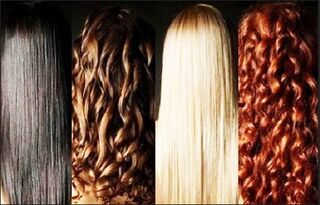Bias
An Examination of Stereotypes About Hair Color
Let's look at the labels "dumb blonde," "brainy brunette," and "fiery redhead."
Posted April 24, 2021 Reviewed by Ekua Hagan
Key points
- Hair color is an important aspect of how people define themselves, and how other people define them.
- Specific hair colors have become associated with various personality traits.
- Hair color actually doesn't tell us a lot about personality, although it can affect how we are perceived or treated by other people.

Hair color is an important aspect of how people define themselves, and how other people define them. Over time, specific hair colors have become associated with various personality traits and studies show that hair colors carry certain perceptions. These stereotypes are associated with our natural hair color: blondes are dumb, brunettes are smart, and redheads have fiery tempers. These stereotypes can even lead to prejudice that affects our careers and personal lives.
Blonde Bombshells and Dumb Blondes
There are many generalizations about people with blonde hair, and blonde women in particular. Blonde hair is often perceived as attractive, glamorous, and sexy. The 1933 film Bombshell starring Jean Harlow popularized the phrase “blonde bombshell,” describing a blonde woman with sex appeal. Similarly, there are the “blonde babe” and the “busty blonde” stereotypes.
Blonde women are also seen as popular and exciting; as the famous saying goes, “blondes have more fun.” Some people dye their hair to align themselves with the stereotypes.
A 1960s advertising campaign for Lady Clairol hair dye asked, “Is it true that blondes have more fun?” This was followed by a slogan that became one of the most famous in advertising history: “If I’ve only one life, let me live it as a blonde.” The invention of hair dye introduced the “fake blonde”, including the “bottle blonde,” “bleach blonde,” or “suicide blonde” (“dyed by her own hand”). The fashion doll Barbie led to the image of the Barbie Doll type, a tanned, busty, blue-eyed blonde. This is the look that inspired Ukrainian model Valeria Lukyanova to transform herself into a “real-life Barbie doll” or “Human Barbie.”
Blonde hair is envied, although blonde women are also stereotyped negatively as vain, promiscuous, naïve, or “stupid.” A blonde woman is thought to rely on her looks rather than her intelligence. It is also stereotyped that men find blonde women to be more attractive than women with other hair colors. These stereotypes are exemplified by the 1953 musical comedy Gentlemen Prefer Blondes. In the film, Marilyn Monroe plays the role of Lorelei Lee, a gold-digging showgirl who performs an iconic rendition of the song, “Diamonds Are a Girl’s Best Friend.”
The “dumb blonde” is a staple of Hollywood movies. In Legally Blonde, Reese Witherspoon’s character Elle Woods earns a law degree at Harvard University, despite giving the initial appearance that she is a “blonde bimbo,” an attractive but scatterbrained woman. There is an entire genre of humor known as “blonde jokes,” which exploit the stereotype that blonde women are unintelligent, while the idiom “to have a blonde moment” is to do something unintelligent or to forget something. Blonde stereotypes are chiefly aimed at women, although there are also the “dumb blonde male” cliches of the “dumb jock” and the “surfer dude.”
Brainy Brunettes and Tall, Dark and Handsome Men
In contrast to the “brainless blonde” is the “brainy brunette.” Brunette women are stereotyped variously as smart, sophisticated, or serious. In Gentlemen Prefer Blondes, Marilyn Monroe’s “ditzy blonde” character is countered by her best friend Dorothy Shaw; a clever, witty, down-to-earth brunette played by Jane Russell. The brunette woman can also be perceived as a wholesome, sensible, girl-next-door type. Brown hair is the most common hair color, and so brunettes may also be characterized as plain-looking and dull, with “boring,” “mousy-brown” colored hair.
Alternatively, Hollywood has a preference for brunette men, especially the man who is “tall, dark, and handsome.” Dark hair is often seen as mysterious and exotic. In popular culture, people with very dark hair are also stereotyped as sinister, untrustworthy, and wicked. Like the "good witch and the bad witch," light hair is often equated with goodness, while dark hair is portrayed as “evil.” In the Marvel Universe movies, the blonde God Thor is a virtuous hero, while his dark-haired adopted brother Loki is a villain.
Fiery Redheads and Gingers
Red hair was the inspiration of noted artists, including Titan, Dante Gabriel Rossetti, and Sandro Botticelli in his famous “The Birth of Venus” painting. Natural red hair is perceived as striking, unusual, and uncommon. It is statistically rare, accounting for only 2-3% of the world’s population.
Paradoxically, redheads have been stigmatized throughout history and have been accused of being vampires, demons, and witches. During the European witch-hunts in the sixteenth and seventeenth centuries, some women were put to death simply because they had red hair, which was believed to be the devil’s mark. This fear of red hair possibly stems from the Biblical story of Judas betraying Christ, because many artworks depict Judas with red hair and a red beard. In France until recently, people with red hair were called poil de Judas, meaning “hair of Judas.”
Today, prejudice against people with natural red hair still exists, which has been likened to racism, while redheads have been called “the white-skinned other." Often called “gingers,” especially in the U.K., prejudice against people with red hair is known as “gingerism.” Red hair is so stigmatized that some red-haired people prefer the terms “strawberry blonde” or “auburn” to having their hair labeled as “orange” or “red."
People with red hair are often assumed to have certain characteristics on the basis of the color of their hair. They are typified as impulsive, quick-tempered, libidinous, and wild. The personalities of people with red hair are often believed to be imitative of their red hair, and they are seen as fiery, hot-tempered, hot-blooded, passionate, and angry.
Many stereotypes exist of people with red hair and, because it is so rare, these generalizations are often a symbolic representation of famous people with red hair. Redheads are supposed to be funny, weird, and wacky, such as comedian Lucille Ball or they are thought of as clownish, such as Ronald McDonald. Irish ethnicity is often attributed to people with red hair, even though Scotland has the highest percentage of red-haired people of any nation. Similarly, Irish stereotypes are attributed to people with red hair, and they are assumed to be Catholic, to be mischievous (like a "redheaded Leprechaun"), and to overindulge in alcohol. There are also generalizations about their skin; that they are a pasty white color, or albino, that they have red freckles, no eyelashes, and that they are not able to go out into the sun at all.
There are many insults and nicknames that refer to red hair, and while some are accepted, many are hated. Common terms refer to red or orange objects and include “carrot top,” “rusty crotch,” and “firehead.” The nickname “Red” can be seen as overly familiar or intimate. Other nicknames are based on the names of red-haired fictional characters, such as Little Orphan Annie and Anne of Green Gables.
“Ginger” is usually pejorative, although it can be used affectionately, as in the adopted name of actress Ginger Rogers, the nickname of Cream drummer Peter “Ginger” Baker, and singer Geri “Ginger Spice” Halliwell. “Ginger” was the name of the sultry, redheaded movie star in the 1960s television comedy Gilligan’s Island. Ginger has also been reclaimed by some people with red hair who use “ginger” as a self-identifying label. But as observed in the comedy song “Prejudice” by Australian musician Tim Minchin, “Only a ginger can call another ginger ‘Ginger.’”
Anti-Red Hair Bias
Red hair becomes the most significant characteristic for those who have it. People with red hair often feel that the color of their hair overpowers everything else, becoming all that people see. They may be identified as “the girl with red hair” or “the guy with red hair.”
The popular stereotypes negatively affect the lives of people with red hair. They often have low self-esteem, experience insecurity, and feel a profound sense of being not only different from other people but also inferior. As implied by the phrase “red-headed stepchild,” people with red hair often feel neglected, mistreated, or unwanted. In 2011, the world’s largest sperm bank, Cryos International, barred red-haired men from donating due to low demand. (By 2014, it was reported that Cryos was now struggling to keep up with the demand for sperm containing the MC1 R gene for red hair.)
Anti-red bias and bullying are common problems, especially in the United Kingdom. A red-headed family in Newcastle, England, endured years of taunts and violence from neighbors. Their windows were smashed, their home was daubed in graffiti, they were punched and kicked, and they moved twice to escape the harassment.
“Ginger Kids,” an episode of the cartoon South Park was a satire of racism and prejudice. The episode description states, “After the sudden onset of the disease Gingervitis, Cartman rallies all ginger kids to rise up and assume their role as the master race. The show had unintended consequences, spawning an unofficial “Kick a ginger kid day” across the UK, in which children with red hair were bullied, attacked, and kicked.
In recent years, there have been a number of suicides related to the bullying of red-haired people. In 2013, 15-year-old Helena Farrell took her own life because of the constant bullying she endured for having red hair.
Of course, there are many stereotypes associated with having other hair colors, such as grey hair or no hair, but let's look at those another time.
Hair color is a unique part of who we are. It's a part of our identity. However, it doesn't tell us a lot about personality, although it can affect how we are perceived or treated by other people.




